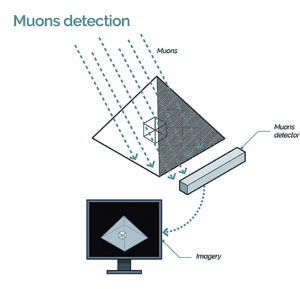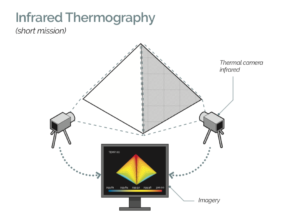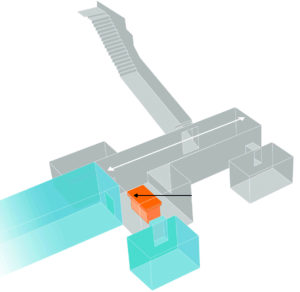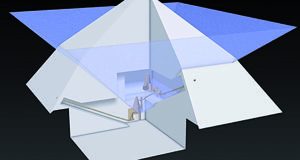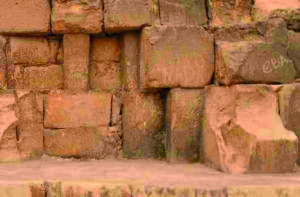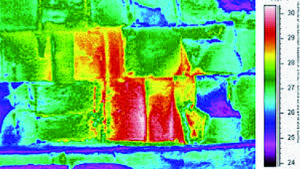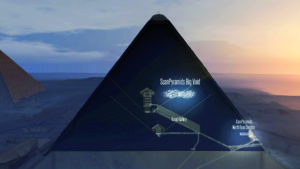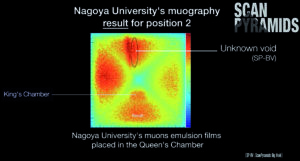“ScanPyramids” Project from 2015 to 2018
In October 2015, a press conference was held at the Mena House Hotel in Giza under the motto “2016 – the year of the pyramids!” and the “ScanPyramids” project was presented. Under the leadership of the Authority of Egyptian Ministry of Antiquities and under the coordination of the Faculty of Engineering Cairo University and the HIP Heritage Innovation Preservation Institute, partners and researchers from Japan, Canada, France and Egypt are working together to scan various pyramids and tombs with the latest technologies. Among them are some well-known partners who have already done research on the Giza Plateau, such as the Universities of Waseda and Nagoya from Japan, the University of Laval from Canada, as well as the University of Aix Marseille and the company Dassault Systèmes from France. It also has smaller partners for departments.
It is the largest multi-site research project in Egypt. Actually, its duration was set for 2016, then it was extended to 2017 and then again to summer 2018. However, the reasons and courses are often unclear and there have been several disagreements and unchecked publications, to which we will return in the case of possible discoveries. In addition, Dr. Zahi Hawass became active again in 2017 and said in interviews that he had now taken over the management of the “ScanPyramids” project, which was officially denied by HIP. Since then, he has been a member of an Egyptian committee that examines the results of “ScanPyramids”. First, Hawass wiped all the results of the first two years off the table. These are wrong, as he said in an interview with “Ahram Online”, which annoyed the researchers of the different teams very much. Hawass doesn’t believe in these scanning techniques either, but it could also be that he is wrong. Only if at least one of the three known chambers of the Great Pyramid can be identified on the scans, will permission be granted for its continuation.
The results are really inaccurate for the effort involved and the running time of more than two years, as we can see immediately. Although three of the most modern scanning methods are used and individual systems have been replaced or modified in the meantime:
• Muons Detection Ground Penetration: Muons are elementary particles that are similar to electrons and penetrate matter. They are formed when cosmic rays hit the atmosphere and then reach the earth’s surface at least once per cm2 / 3.937 in and minute. Reflective plates were used for the scans and the muons were measured with detectors to detect cavities.
Note: In 1968, Dr. Alvarez had already used muon detectors in the Middle Pyramid, but he received different results every day (see page 190).
• Infrared Thermography: Infrared cameras film the thermographic changes. For the scans, the Great Pyramid or its outer sides were measured and filmed at different times of the day in order to detect cavities due to thermal differences.
• Photogrammetry and Laser: Special cameras measure the entire plateau from the ground and from flying drones to produce a 3D model accurate to 5 cm / 0.394 in.
Note:
The “3D technology for virtual worlds” is implemented by La Fondation Dassault Systèmes, which aims to transform the future of education and research. The famous Harvard University is also involved. Visitors to the GEM Grand Egyptian Museum will be able to walk virtually through the pyramids from 2020 (see page 276), which, according to insiders, will make it possible to close the Plateau for visitors.
Let’s take a look at the 4 possible “discoveries” so far.
2015 – Possible cavities in the tomb of Tutankhamun
In August 2015, the British Egyptologist Nicholas Reeves published the theory of 2 more chambers in the Tutankhamun tomb in the Valley of the Kings in Luxor. The basis for this are line structures in two walls in which he sees walled passages, since the stone blocks are not offset.
When the evaluation of the radar images of the Japanese Hirokatsu Watanabe confirmed the possibility of these 2 rooms, the then Minister of Antiquities Al-Damati spoke of a “discovery of the century”.
Further radar measurements followed, this time by two engineers from “National Geographic”, Eric Berkenpas and Alan Turchik, who made 40 scans with different frequencies. Different specialists evaluated the scans and all came to the same conclusion that there were no chambers there. They thus contradicted the previous measurements, which were never published.
Geophysicist Dean Goodman said in “National Geographic”: “If we had a void, we should have a strong reflection. But it just doesn‘t exist.”
In 2016, the first works of “ScanPyramids” followed in this tomb. Then the results of the ground radar scans were presented at a press conference by the Egyptian Ministry of Antiquities, with the result that there could be 2 cavities behind the walls. The quality of the latest Ground Penetrating Radar (GPR) scans is good, but further scans, investigations and evaluations are needed to reach clear conclusions. And the clarification for an “exploration of the 2 hidden chambers by means of a minimal bore” was announced. Nothing had happened by the time this book was completed in April 2018 and, according to insiders, the drilling permit had not been granted. However, this story is certainly not over yet.
Note:
Reeves suspects the tomb and the sarcophagus of Nefertiti, the stepmother of Tutankhamun and according to Reeves‘ theory his predecessor as Pharaoh, behind the north wall. Therefore he was heavily criticized by many Egyptologists. Also by Al-Damati, who suspects there the sarcophagus of Kija, a concubine of Pharaoh Akhenaton, the husband of Nefertiti, the “Great Royal Wife”. Also because Tutankhamun had probably taken Kija with him, not his stepmother Nefertiti, when the seat of government was relocated from Amarna in central Egypt. When he died unexpectedly, the grave laid out for Kija was “the ideal choice”.
In my opinion, Reeves’ thesis does not apply, since the Queens were buried in the Valley of the Queens. Why should this have been any different with the great Nefertiti, and she also died verifiably before Tutankhamun.
2016 – Possible passageway in Snofru Pyramid
In autumn 2016, Japanese and Egyptian scientists presented the first results of the muon scans in the Dahshur Pyramid in Cairo.
They had placed 40 plates in the lower chamber for 40 days, and thus more than 10 million muon traces could be reconstructed. According to the press release of the “ScanPyramids” project, the result is spectacular, because for the first time the inner structure of a pyramid has been made visible with the help of muons.
In fact, the scans also show the upper chamber, which is about 18 m / 59.06 ft above the lower chamber and overlaps it from a bird’s eye view. This is an important test for Giza and the prerequisite for the examination committee.
On the basis of previous evaluations and simulations, the Japanese researchers assume that there are no further cavities or chambers inside the Pyramid of Snofru. Only a possible narrow anomaly was detected, which would rather be a corridor in the middle area, but is not relevant.
The images from the muon scans are simply not yet meaningful, because even the known ducts are not recognizable and even the large chambers are only inaccurate as spots. The floor scans made up for this with their new and perfect representations in 3D.
2016 – Possible 2 cavities in the mantle of the Great Pyramid
At the end of 2016, Hani Helal, project coordinator of HIP, told “Ahram Online” that the thermal infrared scanning teams had detected 2 anomalies on the outside. Both showed temperature differences of up to 6 °C, / 42,8 °F which could not be explained by the differences of the limestone blocks, but indicated cavities absorbing heat or cold. The first anomaly is located in the north side at the upper part of the original entrance area, which was confirmed by muon scans in 2017. The second anomaly lies on the east side in the bottom area. Some experts said that behind the two stone blocks – which appear largely in red on the scans – a passage into the interior begins. Others thought it was just a space in between, which might have been caused by the overexploitation of the facing stones. It was then decided to install a stationary camera to measure this area for a year. Suggested tests by drilling holes or even removing individual blocks were rejected.
2017 – Possible 3 cavities inside the Great Pyramid
The team of the muon scans also found 3 possible cavities within the Great Pyramid. They had placed detector plates at three different locations, at the bottom of the “Queen’s” Chamber, at the bottom of the Gallery and in front of the entrance. All three measurements recorded the hidden cavities after measuring the incident muons for weeks.
The first anomaly at the entrance on the north side has already been mentioned in the thermal scans. The muon researchers suspect that this cavity is another passage. If it were straight, it would be on the level and line with the passage leading to the “Queen’s” Chamber.
The second anomaly is 105 m / 344.5 ft above the ground at the northeast corner. It lies about 6 m / 19.8 ft behind the outside and showed almost exactly the same muon excess as the other two cavities.
The third anomaly caused worldwide excitement because it was a 30 m / 98.5 ft long cavity above the Gallery, which itself is almost 47 m / 154.2 ft long and 8.5 m / 27.1 ft high. The so-called “Big Void” is located at a height of 50-70 m / 164.05-229.7 ft and has no access. Perhaps there are several rooms lying next to each other. According to Japanese particle physicists, the exact shape and direction of the cavity is still unknown, but its existence is 99.999% certain. And the fact that they were able to see the new cavities on their scans as well as the “King’s” Chamber and the Gallery makes the researchers even more confident.
This latest discovery was published by Kunihiro Morishima of the University of Nagoya and Mehdi Tayoubi of the HIP Institute in the “Nature” journal (DOI: 10.1038/nature24647). But after the probably somewhat hasty publication, without consultation with and permission of the management of “ScanPyramids”, there were immediately revocations and a controversy between the partners involved.
Tayoubi said in Paris at a telephone conference organised by “Nature” that all measurements had confirmed the existence of the “Big Void” and that a publication had been decided upon afterwards.
Even the Secretary General of the SCA Supreme Council of Antiquities, Dr. Mostafa Waziri, criticised the research teams for their hasty conclusions from the scan images and for not consulting the scientific committee beforehand.
Various Egyptologists doubt the results of the scan recordings and say that a change in the origin of the limestone blocks from different quarries could also be the cause of the changes in the muon flow. However, this assumption was rejected by the authors of the “Nature” article.
Dr. Zahi Hawass pointed this out in an interview with the “Live Science” magazine:
The measurement differences could indicate small gaps between the stone blocks, since the core of the pyramid consists of stones of different sizes. And he told the “AFP” news agency that it was known that the pyramid was full of cavities. However, this does not mean that it is a new discovery. Miroslav Barta of Charles University in Prague – with Zahi Hawass a member of the scientific committee for “ScanPyramids” – said in an interview with the the German “SPIEGEL” magazine that he had mixed feelings about the results presented. The project works with high-tech, is important, has produced good data and is an enrichment. He also did not doubt the scan results on the north side of the pyramid and even said that the participating researchers were reluctant in their interpretations. But he did not yet believe in a large chamber and called it a “structural element”. The architects of Egyptian pyramids had thought practically at that time and in order to distribute the load of the countless stones better, it was not unusual to fill cavities in the structure with sand and gravel.
Mark Lehner also shares this thesis of a “Relieving” Chamber.
Then several reports appeared on the Internet with a comparison to the 5 “Relieving” Chambers above the “King’s” Chamber. The top two are almost at the same height and closest to the possible cavity. Unfortunately, it was never mentioned that in the meantime it has been scientifically proven that they do not have this statically relieving effect at all (see page 48).
Hany Helal of the University of Cairo and project coordinator of HIP also contradicts this interpretation of the relief. From their point of view, it is too early to say what the purpose of this cavity could be. It is certainly not accidentally placed at this point of the pyramid, but too large for a “Relieving” Chamber.
In contrast to Waziri, Hawass, Barta and Lehner, the current Minister of Antiquities, Khaled Al-Anany, spoke positively about these discoveries, as the “Egypt Independent” reported. At the SAEMT (International Conference on the Science of Ancient Egyptian Materials and Technologies) he thanked the teams of “ScanPyramids” under Mehdi Tayoubi (HIP Institute) and Kunihiro Morishima (Nagoya University). Al-Anany spoke of a “revelation” that would redirect the interest of the world back to Egypt. What was discovered in the Great Pyramid is new and bigger than all known cavities and will continue to be scientifically investigated and researched.
Further measurements and investigations in the current year 2018 will show whether these really are previously unknown spaces or only natural crevices and cavities. The biggest problem is that the presumed cavities are obviously not connected to other corridors or spaces. To find them one would have to drill and dig into the Great Pyramid, which has never been officially approved. We’ll see what “ScanPyramids” and the leadership will finally present.
This is an excerpt from the book GIZA LEGACY.

